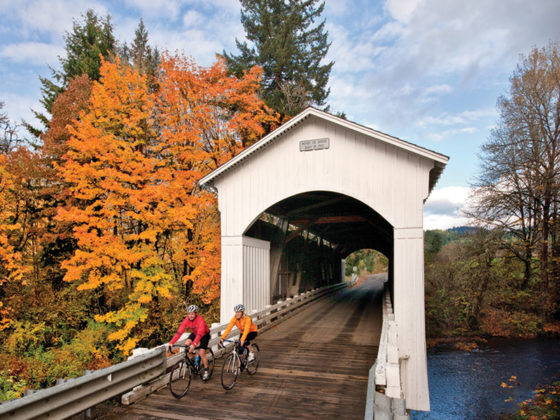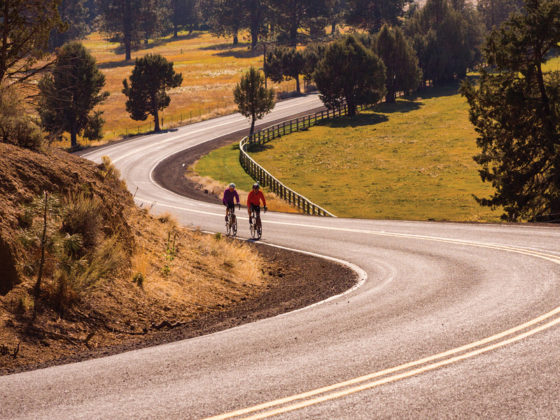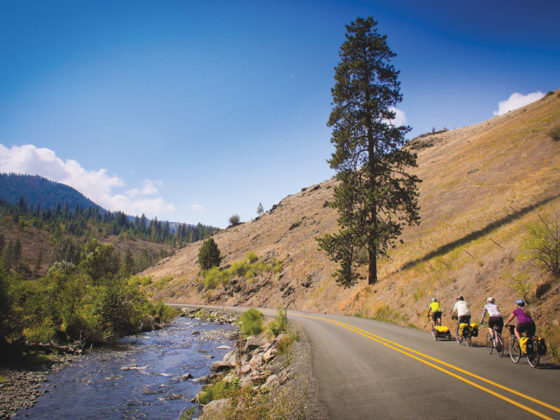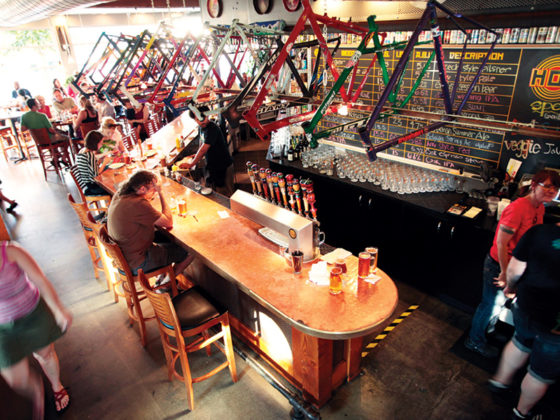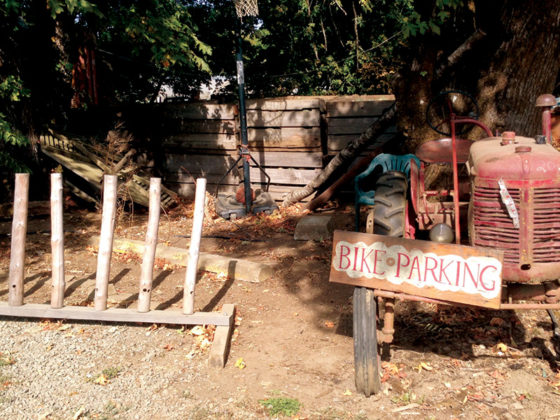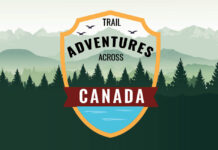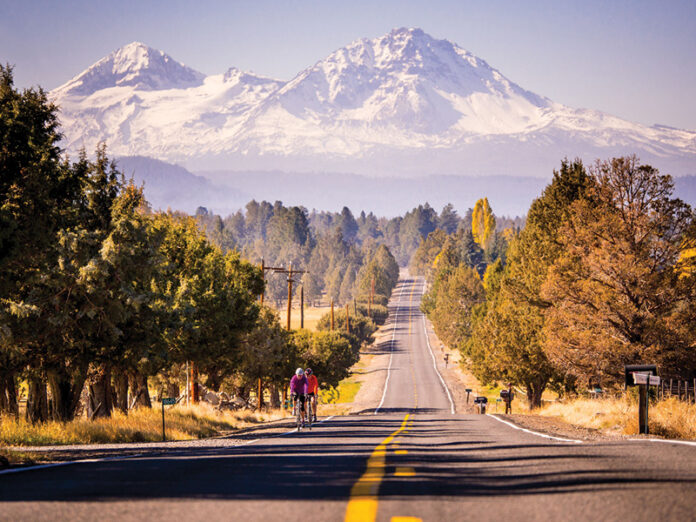
Lewis and Clark may have discovered the Oregon Trail via horseback and canoe back in 1805, but today’s adventurous souls have endless opportunity to explore the region on two-wheeled steeds. Oregon is the only state to have designated scenic bikeways and has eclipsed other regions as a progressive cycling destination.
“The purpose was to showcase all that Oregon has to offer — the best scenic, historic, natural and cultural experiences — all from the seat of a bike,” says Alex Phillips, the state’s bicycle recreation specialist.
The development of the bikeways was a collaboration of Cycle Oregon, and the state departments of travel, transportation and parks, which worked together on a program to promote outdoor activity — specifically cycling — according to Phillips.
The first route to be designated was the Willamette Valley Scenic Bikeway back in 2005. It became the prototype for subsequent projects, including a key development requirement that a local cycling enthusiast, someone who “rides the road,” be the designer and champion for all future routes. The next bikeways took some time and were not designated until 2011, but proposals for additional routes clamour to be recognized by the state annually as local businesses see the benefits brought in by increased cyclo-tourism.
The current bikeway count is 12 official routes divided into four categories: mild, moderate, challenging and extreme. They range in length from 37 to 280 kilometres. The Covered Bridges bikeway is suitable for any recreational rider, while Cascading Rivers is comprised of one monster climb for hard core cyclists seeking training terrain.
Invited to ramble down the 212 kilometre Willamette Valley Scenic Bikeway last September, I could not turn down the fitness and gastronomic challenge. Oregon’s self-proclaimed “movable feast,” the route follows the Willamette River from Portland to Eugene. We rode it in reverse, beginning our ride near Eugene at the south end of the valley.
Home to many great local breweries, the city provided liquid sustenance that made the next morning’s brisk fall temperature a welcome awakening. Heading north from the official start at Armitage State Park, wide open farmland warmed up our legs nicely, but 30K in, a climb to 218 metres (the highest elevation on the route) provided not only the first challenge, but sweeping forest views, showing off Oregon’s beautiful landscape.
Descending into the town of Brownsville was a step back in time with quaint coffee shops housed in historical buildings inviting us in for a mid-morning caffeine fix. The next 30K provided enough agricultural distractions to neutralize the leg burn induced by rolling hills. We detoured to the university town of Corvallis where we were rewarded with a leisurely lunch at one of many riverfront hipster restaurants. The last 15K of Day 1 wound through hazelnut and walnut farms to Albany, a quaint town for an overnight stop 90K into the ride.
On Day 2, the scenery opened to lush vegetation including vineyards, hops farms and fruit orchards. The grind up Scravel Hill at 100K worked off the previous night’s culinary indulgences. The descent lured us to assume drop position, gaining mileage before exhilarating hills, valleys and curvy roads led into Salem, the state capital, at 160K. The next 50K skirted wine country towns such Carlton, McMinnville and Dayton, which all offer overnight options; our stay in Dundee included fuelling up on locavore offerings of pork, mushrooms and perfectly paired pinots.
The bikeway ends at Champoeg State Park, but the ambitious have a few options from here. Cycle 30K to Oregon City, official end of the Oregon Trail and home to a bike friendly Amtrak station including a cycling resource centre, bistro and deli, or continue on another 35K directly to Portland’s city centre.
There is also the epicurean alternative — Highway 99 West from Champoeg to Portland cuts through the heart of the Willamette Valley, home to more than 200 wineries that invite the saddle weary in for well deserved tasting detours. The highway is busy, but has a designated cycling lane for safety.
All bikeways are easy to navigate with helpful signage along the way. The Oregon State website provides an overview map of each ride, detailed section maps (including elevation) and directional cues, as well as links for GPS mapping. Ride Oregon posts additional tips based on rider feedback about current conditions.
Riding year round is possible, but pack rain gear if you plan your trip between November and April. July and August are guaranteed to be dry, but shoulder seasons provide opportunity to enjoy the spring bloom and fall foliage. So why go?
Lewis and Clark did not endure hardship for naught; taking a two-wheeled journey through Oregon’s diverse landscapes with the support of local cycling communities, their welcoming residents, no sales tax and gastronomic adventures guarantee this state a continuous influx of new explorers.
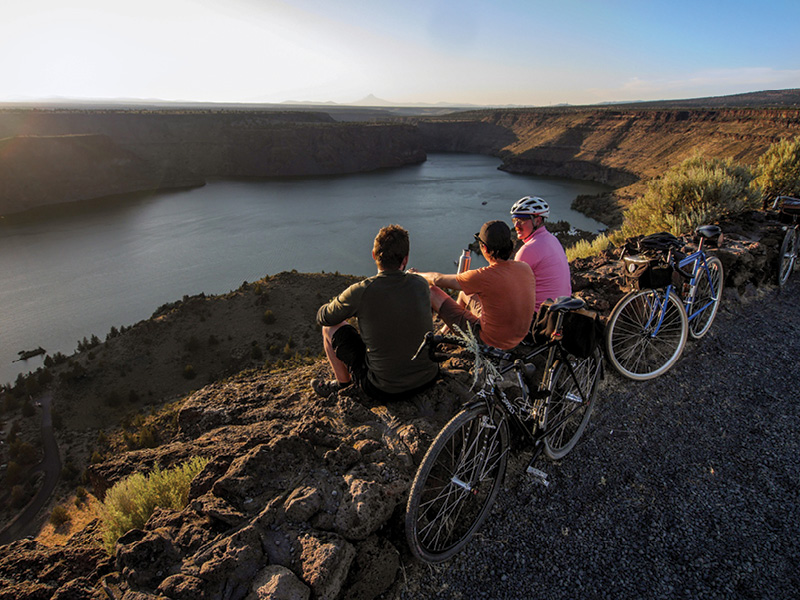
Explore Oregon
- Getting Around: Fly or drive into Portland, direct from Vancouver (500K) or Calgary (1,200K) or connecting flights from other Canadian cities.
- Try Amtrack Within Oregon: i.e. Portland to Eugene in 2.5 hours for $30, $5 extra for your bike. amtrak.com
- Bike Concierge: Ship your bike ahead for assembly and assistance with any ground transportation needs. thebikeconcierge.com
- Rest Stop: Stay at bike friendly hotels: Inn at the 5th in Eugene or Albany’s Best Western Plus Prairie Inn.
- Fuel Up: Enjoy whiskey and house-made chocolate pairings at Rye in Eugene; eat local, wild-foraged cuisine with chef Matt Bennett at Sybaris Bistro in Albany; plan a side trip to a Mecca of artisan brewers and winemakers including Agrarian Ales and Ankeny Cellars right on the bikeway.
State of Play
There’s a trail for every level of rider along the Oregon Scenic Bikeway trail system. Here’s the lowdown:
[Trail Name | Distance (kilometres) | Elevation Gain (metres)]
MILD: For riders of all abilities
- Covered Bridges | 58K loop starts and ends in Cottage Grove | 365m
- Metolius River Loops | 3 loops start and end at Camp Sherman Fly Shop plus one out and back for a total of 37K | 290m
MODERATE: Experience recommended
- Madras Mountain Views | 50K loop starts and ends in Madras; high elevation | 360m
- Sisters to Smith Rock | 60K rolling terrain mostly downhill | 213m
- Tualatin Valley | 70K loop near Portland | 30m
- Twin Bridges | 58K loop starts and ends in Bend; rolling hills, high elevation | 450m
- Willamette Valley | 215K starts near Oregon City ends near Eugene | 450m
CHALLENGING: Long rides at high elevation for good riders
- Grande Tour | 215K figure 8 starts and ends in La Grande | 1,370m
- Cascading Rivers | 112K starts in Estacada and ends in Detroit | 1,066m
- Old West | 280K loop starts and ends in John Day | 1,370m
EXTREME: Epic rides with serious elevation changes
- McKenzie Pass | 61K starts in Sisters and ends at Belknap Hot Springs | 1,220m
- Blue Mountain Century | 175K loop starts and ends in Heppner | 2,440m


